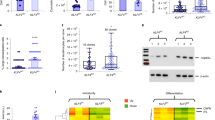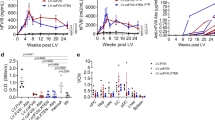Abstract
Haemophilia B might be permanently cured by gene therapy — the introduction of a correct copy of the factor IX gene into the somatic cells of a patient. Here, we have introduced a recombinant human factor IX cDNA into primary human keratinocytes by means of a defective retroviral vector. In tissue culture, transduced keratinocytes were found to secrete biologically active factor IX and after transplantation of these cells into nude mice, human factor IX was detected in the bloodstream in small quantities for one week. This is the first demonstration of a therapeutic protein reaching the bloodstream from transduced primary keratinocytes. This may have implications for the treatment of haemophilia B and other disorders.
This is a preview of subscription content, access via your institution
Access options
Subscribe to this journal
Receive 12 print issues and online access
$209.00 per year
only $17.42 per issue
Buy this article
- Purchase on Springer Link
- Instant access to full article PDF
Prices may be subject to local taxes which are calculated during checkout
Similar content being viewed by others
References
Hedner, U. & Davie, E.W. Introduction to haemostasis and the vitamin K-dependent coagulation factors The Metabolic Basis of Inherited Disease 6th edn (eds Scriver, C. R. et al.) 2107–2134 (McGraw-Hill, New York, 1989).
Anson, D.S. et al. Towards gene therapy for haemophilia B. Molec. biol. Med. 4, 11–20 (1987).
St Louis, D. & Verma, I.M. An alternative approach to somatic cell gene therapy. Proc. natn. Acad. Sci. U.S.A. 85, 3150–3154 (1988).
Palmer, T.D., Thompson, A.R. & Miller, A.D. Production of human factor IX in animals by genetically modified skin fibroblasts: Potential therapy for haemophilia B. Blood 73, 438–445 (1989).
Axelrod, J.H., Read, M.S., Brinkhous, K.M. & Verma, I.M. Phenotypic correction of factor IX deficiency in skin fibroblasts of haemophiliac dogs. Proc. natn. Acad. Sci. U.S.A. 87, 5173–5177 (1990).
Yao, S.-N. & Kurachi, K. Expression of human factor IX in mice after injection of genetically modified myoblasts. Proc. natn. Acad. Sci. U.S.A. 89, 3357–3361 (1992).
Yao, S.N. et al. Expression of human factor IX in rat capillary endothelial cells: Toward somatic gene therapy for haemophilia B. Proc. natn. Acad. Sci. U.S.A. 88, 8101–8105 (1991).
Armentano, D., Thompson, A.R., Darlington, G. & Woo, S.L.C. Expression of human factor IX in rabbit hepatocytes by retrovirus-mediated gene transfer: Potential for gene therapy of haemophilia B. Proc. natn. Acad. Sci. U.S.A. 87, 6141–6145 (1990).
Fenjves, E.S. et al. Prospects for epithelial gene therapy. DNA Damage and Repair in Human Tissues (eds Sutherland, B.M. & Woodhead, A.D.) 215–223 (Plenum Press, New York, 1990).
Morgan, J.R., Barrandon, Y., Green, H. & Mulligan, C.R. Expression of an exogenous growth hormone gene by transplantable human epidermal cells. Science 237, 1476–1479 (1987).
Teumer, J., Lindahl, A. & Green, H. Human growth hormone in the blood of athymic mice grafted with cultures of hormone-secreting human keratinocytes. FASEB J. 4, 3245–3250 (1990).
Furie, B. & Furie, B.C. The molecular basis of blood coagulation. Cell 53, 505–518 (1988).
Wu,S.-M., Cheung, W.-F., Frazier,D. & Stafford, D.W. Cloning and expression of the cDNA for human γ-glutamyl carboxylase. Science 254, 1634–1636 (1991).
Barrandon, Y., Li, V. & Green, H. New Techniques forthe grafting of cultured epidermal cells onto athymic animals. J. Invest. Dermatol. 91, 315–318 (1988).
Flowers, M.E.D. et al. Long-term transplantation of canine keratinocytes made resistant to G418 through retrovirus-mediated gene transfer. Proc. natn. Acad. Sci. U.S.A. 87, 2349–2353 (1990).
Palmer, T.D., Rosman, G.J., Osborne, W.R.A. & Miller, A.D. Genetically modified skin fibroblasts persist long after transplantation but gradually inactivate introduced genes. Proc. natn. Acad. Sci. U.S.A. 88, 1330–1334 (1991).
Scharfmann, R., Axelrod, J.H. & Verma, I.M. Long-term in vivo expression of retrovirus-mediated gene transfer in mouse fibroblast implants. Proc. natn. Acad. Sci. U.S.A. 88, 4626–4630 (1991).
Gerrard, A.J., Austen, D.E.G. & Brownlee, G.G. Subcutaneous injection of factor IX for the treatment of haemophilia B. Br. J. Haematol. 81, 610–613 (1992).
Stern, D.M., Drillings, M., Nossel, H.L., Hurlet-Jensen, A., LaGamma, K.S. & Owen, J. Binding of factors IX and IXa to cultured vascular endothelial cells. Proc. natn. Acad. Sci. U.S.A. 80, 4119–4123 (1983).
Fuchs, H.E., Trapp, H.G., Griffith, M.J., Roberts, H.R. & Pizzo, S.V. Regulation of factor IXa in vitro in human and mouse plasma and in vivo in the mouse. J. clin. Invest. 73, 1696–1703 (1984).
Biggs, R. & Denson, K.W.E. The fate of prothrombin and factors VIII, IX and X transfused to patients deficient in these factors. Br. J. Haematol. 9, 532–547 (1963).
Fenjves, E.S., Gordon, D.A., Pershing, L.K., Williams, D.L. & Taichman, L.B. Systemic distribution of apolipoprotein E secreted by grafts of epidermal keratinocytes: Implications for epidermal function and gene therapy. Proc. natn. Acad Sci. U.S.A. 86, 8803–8807 (1989).
Coruh, G. & Mason, D.Y. Serum proteins in human squamous epithelium. Br. J. Dermatol. 102, 497–505 (1980).
Anson, D.S., Austen, D.E.G. & Brownlee, G.G. Expression of active human clotting factor IX from recombinant DNA clones in mammalian cells. Nature 315, 683–685 (1985).
Miller, A.D. & Rosman, G.R. Improved retroviral vectors for gene transfer and expression. BioTechniques 7, 980–190 (1989).
Anson, D.S. et al. The gene structure of human anti-haemophiliac factor IX. EMBO J. 3, 1053–1060 (1984).
Miller, A.D. & Buttimore, C. Redesign of retrovirus packaging cell lines to avoid recombination leading to helper virus production. Molec. cell. Biol. 6, 2895–2902 (1986).
Miller, A.D., Trauber, D.R. & Buttimore, C. Factors involved in production of helper virus-free retrovirus vectors. Somat. Cell. molec. Genet. 12, 175–183 (1986).
Rheinwald, J.G. & Green, H. Serial cultivation of strains of human epidermal keratinocytes: the formation of keratinizing colonies from single cells. Cell 6, 331–344 (1975).
Smith, K.J. & Ono, K. Monoclonal antibodies to factor IX: characterization and use in immunoassays for factor IX. Thromb. Res. 33, 211–224 (1984).
Yoshioka, A., Giddings, J.C., Thomas, J.E., Fujimura, Y. & Bloom, A.R. Immunoassays of factor IX antigen using monoclonal antibodies. Br. J. Haematol. 59, 265–275 (1985).
Handford, P.A., Winship, P.R. & Brownlee, G.G. Protein engineering of the propeptide of human factor IX. Protein Engineering 4, 319–323 (1991).
Lin, S.W., Smith, K.J., Welsch, D. & Stafford, D.W. Expression and characterization of human factor IX and factor IX-factor X chimeras in mouse C127 cells. J. biol. Chem. 265, 144–150 (1990).
Austen, D.E.G. & Rhymes, I.L. Laboratory Manual of Blood Coagulation (Blackwell Scientific, Oxford, 1975).
Jacobs, J.P., Jones, C.M. & Bailie, J.P. Characteristics of a human diploid cell designated MRC-5. Nature 227, 168–170 (1970).
Author information
Authors and Affiliations
Rights and permissions
About this article
Cite this article
Gerrard, A., Hudson, D., Brownlee, G. et al. Towards gene therapy for haemophilia B using primary human keratinocytes. Nat Genet 3, 180–183 (1993). https://doi.org/10.1038/ng0293-180
Received:
Accepted:
Issue Date:
DOI: https://doi.org/10.1038/ng0293-180
This article is cited by
-
Genome-edited skin epidermal stem cells protect mice from cocaine-seeking behaviour and cocaine overdose
Nature Biomedical Engineering (2018)
-
A Study of the Expression of Functional Human Coagulation Factor IX in Keratinocytes Using a Nonviral Vector Regulated by K14 Promoter
Applied Biochemistry and Biotechnology (2010)
-
Developing macromolecular therapeutics: the future drug-of-choice
Frontiers of Chemical Engineering in China (2010)
-
Use of a Bacterially Expressed Human Factor IX Light Chain to Develop Polyclonal Antibody Anti-hFIX
Applied Biochemistry and Biotechnology (2009)
-
Long-term culture of keratinocyte-like cells derived from mouse embryonic stem cells
In Vitro Cellular & Developmental Biology - Animal (2008)



